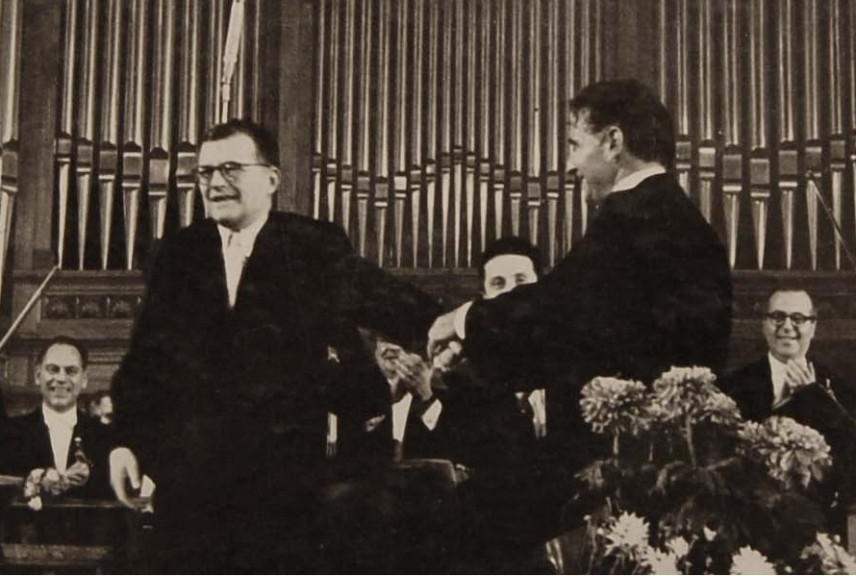Dmitri Shostakovich Remembered in 5 Works

Dmitri Shostakovich with Leonard Bernstein in 1959
Russian composer Dmitri Shostakovich (1906–1975) was one of the most consequential symphonic composers of the 20th century, producing a diverse body of work that at times put his life and career in jeopardy when he contravened the Soviet Party’s vague yet imperative stylistic demands. In honor of the fiftieth anniversary of his passing on August 9, we've highlighted five of our favorite Shostakovich works as a way to learn more about this complex figure.
Symphony No. 5
Shostakovich became known as a great symphonist from the outset of his career. His First Symphony, written at the tender age of 19, immediately thrust him into the public eye. Arguably his greatest symphony—and one of the greatest of the 20th century—is his Fifth, written while he was under intense scrutiny during Stalin’s purges of the 1930s. In January 1936, shortly after Stalin attended a performance of Shostakovich’s opera Lady Macbeth of Mtsensk, an anonymous article in the Pravda, rumored to be at the behest of Stalin himself, condemned the opera as “Un-Soviet, unwholesome, cheap, eccentric, tuneless and leftist.” Many of Shostakovich’s fellow composers joined in the public denouncement to save their own skins.
These criticisms and the prevailing atmosphere of fear shook Shostakovich to his core. Several of his family members and artistic associates had been arrested during the purges, and he allegedly contemplated suicide. In November, he decided to shelve his Fourth Symphony for fear that its dissonant nature would arouse further criticism. So, he went back to the drawing board the following spring to work on a new symphony that would pass the Kremlin’s litmus test.
When his Fifth Symphony premiered in November 1937, it received a 30-minute ovation. The audience wept openly during the sumptuous Largo movement in a mass exhalation of suppressed grief at the height of the Great Terror. The overwhelming success of Shostakovich’s Fifth Symphony marked his official “rehabilitation” and reaffirmed his status as a Soviet cultural hero. But he would never take that designation for granted again.
Piano Concerto No. 2
Shostakovich eventually learned how to bend his aesthetics to adhere to the Party’s stylistic demands while maintaining his own creative integrity. The phenomenon of “The Two Shostakoviches” emerged—one for public consumption and one for private artistic fulfilment. He began to direct his public style toward the lyrical and heroic to appease the Kremlin while also incorporating hidden meanings that could subvert superficial readings. A master of satire, he learned how to blur the line between authenticity and irony so that he could remain above suspicion, largely leaving the subtext to the imagination of the listener.
One of Shostakovich’s most popular “public” works is his uncharacteristically cheerful and accessible Piano Concerto No. 2. Shostakovich composed the work in 1957 for the 19th birthday of his son Maxim. Aspiring to be a pianist like his father, Maxim premiered the work in May as an advanced piano student at the Moscow Conservatory. In a letter to a composition student, Shostakovich wrote that his Second Piano Concerto had “no artistic value.” However, like anything Shostakovich is purported to have said, you have to take it with a grain of salt. This statement might have been a tongue-in-cheek jibe at the authorities, or he was preempting criticism by disparaging the work himself first. Regardless, the concerto has proved to be one of Shostakovich’s most popular pieces, featuring rhythmically energetic outer movements and a profoundly heartfelt Andante.
String Quartet No. 4
Representing one of his “private” works is Shostakovich’s String Quartet No. 4. Composed in 1949, the work did not premiere until after Stalin’s death and ensuing “thaw” in 1953, having been stashed away in a drawer until it was safe to see the light of day.
The cultural climate had shifted markedly since World War II. The conflict had distracted Stalin’s government from conducting its notorious witch hunts of artists and intellectuals, but once the war was over, Stalin became increasingly paranoid, and the purges resumed. In 1948, the Central Committee of the Communist Party, led by Stalin watchdog Andrei Zhdanov, had published a doctrine banning musical works that did not comply with the nebulous principles of “socialist realism.” The decree accused Shostakovich and many of his colleagues of “formalism” and “cosmopolitanism” (an anti-Semitic euphemism), branding him an enemy of the people. Shostakovich was blacklisted and forced to atone with a stream of outwardly patriotic works. However, he continued to compose works for his own private artistic fulfillment.
String Quartet No. 4 was one of those pieces. The oppression Shostakovich faced during this time profoundly affected him. He came to identify himself closely with other victims of persecution, particularly the Russian Jews who were targeted under the same “anti-cosmopolitan” campaign. As a means of solidarity and veiled protest, Shostakovich integrated elements of Jewish folk music into many of his “private” works, including String Quartet No. 4, which prominently features a Jewish dance theme.
Symphony No. 11 “The Year 1905”
Shostakovich’s Symphony No. 11 “The Year 1905” is both outwardly patriotic in its commemoration of a landmark event in Russian history, but also subversive in its potential allusions to contemporary events. Commissioned for the 40th anniversary of the Bolshevik Revolution, the symphony depicts the “Bloody Sunday” massacre of 1905. That day, thousands of demonstrators marched toward the Winter Palace in St. Petersburg to petition Tsar Nicholas II for help amid dire working conditions and starvation. Unbeknownst to them, the Tsar had left the city at the last minute in anticipation of the march. The police ordered the increasingly restless crowd to disperse. Amid the confusion, a group of nervous Cossack troops opened fire, ultimately killing over 1,000 people.
Shostakovich began working on the symphony in September 1956, a month before the Hungarian Uprising in Budapest, in which 20,000 dissidents took to the streets in protest of Soviet influence in Hungary. Thousands were killed in firefights and by Soviet tanks that rolled in to crush the national uprising on November 4. Whether Shostakovich was truly aware of what was going on at the time is not clear; it is therefore difficult to say whether he had current events in mind while composing this symphony, though it is easy to draw parallels between the two events. However, he allegedly supported such readings after the fact. Regardless, Shostakovich’s disdain for those in power who use violence as a means of suppressing opposition is clear.
Waltz No. 2
Of course, a list of some of Shostakovich’s best-known works cannot omit his most recognizable piece, “Waltz No. 2.” Shostakovich composed what has become known as “Waltz No. 2” in 1955–56 for Mikhail Kalatozov’s film The First Echelon. It marks just one of nearly 40 films Shostakovich scored between 1923 and 1970. Shostakovich had a knack for composing for the stage and screen. As a teenager, he helped his family make ends meet by accompanying silent films on the piano at movie palaces in St. Petersburg. He learned how music could express psychological and emotional undertones such that the score was not just an accessory but could help tell the story.
In the late 1950s, someone—probably Shostakovich—arranged an orchestral suite of music from musical theater and film of the 1930s to 1950s to create Suite for Variety Orchestra. “Waltz No. 2” is the seventh number of eight in the suite (mistakenly identified as “Suite for Jazz Orchestra” for many years due to a clerical error). The name “Variety Orchestra” relates to its inclusion of instruments found in a dance band, including saxophones, guitar, and accordion. This scoring gives it a light, carnivalesque feel. As with all of Shostakovich’s music, the simple, catchy main melody, set against the stereotypical “oom-pah-pah” rhythm of the waltz, still comes across as slightly off-kilter and ironic, as if something sinister lay under the surface.



